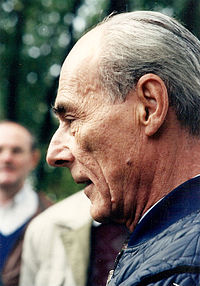Prince Tomislav of Yugoslavia
| Prince Tomislav | |
|---|---|
 | |
| Born | 19 January 1928 Old Royal Palace, Belgrade, Kingdom of Serbs, Croats and Slovenes |
| Died | 12 July 2000 (aged 72) Topola, Serbia, FR Yugoslavia |
| Burial | |
| Spouse | |
Prince Michael | |
| House | Karađorđević |
| Father | Alexander I of Yugoslavia |
| Mother | Maria of Romania |
| Military career | |
| Allegiance | |
| Service/ | |
| Years of service | 1944–1945 |
| Rank | Petty officer 1 class |
Prince Tomislav of Yugoslavia (
Early life and education
Prince Tomislav was born on 19 January 1928, on
He was
At the beginning of February 1928, a delegation was sent from Županjac (present-day Tomislavgrad) headed by the parish priest Šimun Ančić who handed Alexander the resolution in which the population of the Srez of Županjac asks him to change the name of the srez to Tomislavgrad, in honour of his son and Tomislav of Croatia. Not long after, Alexander granted them their petition but dropped Tomislav of Croatia from his decree.[2]
He began his elementary education at the Belgrade Palace but in 1937 he started to attend
Events in Yugoslavia
In 1934 when he was only six, Prince Tomislav's father,
After initially declaring neutrality, on 25 March 1941, although King Peter and his advisors were opposed to Nazi Germany, the Regent, Prince Paul, under immense German pressure signed the
King Peter was forced to leave the country with the
On 29 November 1945, while still in exile,
Life in exile
After Cambridge, and not being able to return to Yugoslavia following the abolition of the monarchy, Prince Tomislav remained in the UK and devoted himself to fruit growing. While he attended agricultural college, he worked summers as an ordinary field hand in an orchard in Kent. In 1950, he bought a farm at Kirdford, near Petworth, in West Sussex, and subsequently specialized in growing apples, having at one point 17,000 trees on 80 hectares of land.[4]
He supported the Serbian community and the
Return to Yugoslavia
He was the first member of the ex-royal family who permanently moved back to Serbia, in early 1992, making his residence at the King Peter I Foundation Complex in Oplenac, Serbia.
He frequently visited the Serb soldiers in
After publicly accusing Serbian president
He became terminally ill; however, he turned down offers for surgery abroad at the time
He died after five years of illness on 12 July 2000, on
Marriage and issue
He was married on 5 June 1957, in Salem, Baden-Württemberg, West Germany, to Princess Margarita of Baden, niece of Prince Philip, Duke of Edinburgh. Tomislav and Margarita were divorced in 1981. They had two children;
- Prince Nikola of Yugoslavia (born 15 March 1958, London); married to Ljiljana Licanin (b. 12 December 1957 in Zemun, Serbia) on 30 August 1992 in Denmark. They have a daughter:
- Princess Marija (b. 31 August 1993, Belgrade).
- Sir Desmond de Silva QC, KStJ (b. 13 December 1939 Sri Lanka), has a daughter and works in public relations.[citation needed] The couple is now divorced.
- Victoria Marie Esmé Margarita de Silva (b. 6 September 1991).
On 16 October 1982, he married Linda Mary Bonney (b. 22 June 1949, London) at the Serbian Orthodox Church of St Lazar, Bournville, Worcestershire; they had two sons:
- Prince George of Yugoslavia (b. 25 May 1984 at Portland Hospital, London). Married Fallon Rayman (b. 5 September 1995 in Guildford, Surrey) on 5 July 2016 at Gretna Green.
- Has two daughters:
Ancestry
| Ancestors of Prince Tomislav of Yugoslavia | |||||||||||||||||||||||||||||||||||||||||||||||||||||||||||||||||||||||||||||||||||||||||||||||||||||||||||||||||||||||||||||||||||||||||||||||||||||||||||||||||||||||||||||||||||||||||||||||||||||||||||||||||||||||||||||||||||||||||||||||||||||||||||||||||||||||||||||||||||||||||
|---|---|---|---|---|---|---|---|---|---|---|---|---|---|---|---|---|---|---|---|---|---|---|---|---|---|---|---|---|---|---|---|---|---|---|---|---|---|---|---|---|---|---|---|---|---|---|---|---|---|---|---|---|---|---|---|---|---|---|---|---|---|---|---|---|---|---|---|---|---|---|---|---|---|---|---|---|---|---|---|---|---|---|---|---|---|---|---|---|---|---|---|---|---|---|---|---|---|---|---|---|---|---|---|---|---|---|---|---|---|---|---|---|---|---|---|---|---|---|---|---|---|---|---|---|---|---|---|---|---|---|---|---|---|---|---|---|---|---|---|---|---|---|---|---|---|---|---|---|---|---|---|---|---|---|---|---|---|---|---|---|---|---|---|---|---|---|---|---|---|---|---|---|---|---|---|---|---|---|---|---|---|---|---|---|---|---|---|---|---|---|---|---|---|---|---|---|---|---|---|---|---|---|---|---|---|---|---|---|---|---|---|---|---|---|---|---|---|---|---|---|---|---|---|---|---|---|---|---|---|---|---|---|---|---|---|---|---|---|---|---|---|---|---|---|---|---|---|---|---|---|---|---|---|---|---|---|---|---|---|---|---|---|---|---|---|---|---|---|---|---|---|---|---|---|---|---|---|---|---|---|---|
| |||||||||||||||||||||||||||||||||||||||||||||||||||||||||||||||||||||||||||||||||||||||||||||||||||||||||||||||||||||||||||||||||||||||||||||||||||||||||||||||||||||||||||||||||||||||||||||||||||||||||||||||||||||||||||||||||||||||||||||||||||||||||||||||||||||||||||||||||||||||||
Footnotes
- ^ Yust, Walter (ed.) Encyclopædia Britannica: A New Survey of Universal Knowledge, Vol 1, 1951, p 573
- ^ Krišto 2000, p. 44.
- ^ Josef Korbel, Tito's Communism (University of Denver Press, 1951), 22.
- ^ "Obituary: Prince Tomislav of Yugoslavia". The Daily Telegraph.
- ^ "Faded royals hold rare Serbian wedding". The Nation. 24 October 2016. Retrieved 4 January 2018.
- ^ "WEDDING OF PRINCE MIHAILO AND PRINCESS LJUBICA KARADJORDJEVIC". The Royal Family of Serbia. 23 October 2016. Retrieved 4 January 2018.
- ^ "Prince Mihailo and princess Lljubica welcome their first child". The Royal Family of Serbia. 27 December 2018. Retrieved 26 December 2018.
- ^ "ISIDORA KARADJORDJEVIC IS BORN". The Royal Family of Serbia. 17 May 2022.
Bibliography
- Krišto, Jure (2000). "Duvanjski kraj kroz povijest" [The region of Duvno through history]. In Krišto, Jure (ed.). Duvanjski zbornik [The collection of papers of Duvno] (in Croatian). Zagreb-Tomislavgrad: Hrvatski institut za povijest–Naša ognjišta–Zajednica Duvnjaka Tomislavgrad. ISBN 9536324253.
